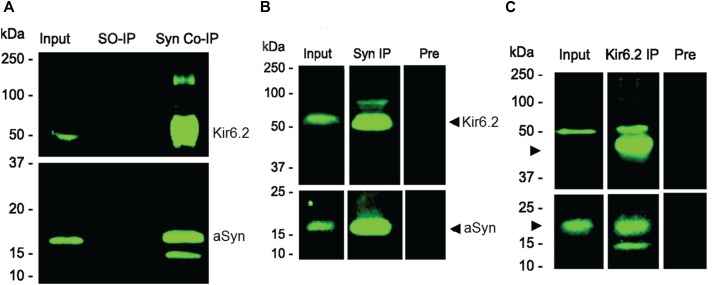FIGURE 1.
Co-immunoprecipitation (Co-IP) of Kir6.2 with aSyn from pancreas (A) and from pancreatic islet cell cultures (B,C). (A) Anti-aSyn antibody (BD Biosciences, Cat # BD610787) was used to immunoprecipitate aSyn protein from mouse pancreatic tissue extracts. Immunocomplexes are characterized on immunoblots using anti-Kir6.2 (Santa Cruz Biotechnology, Cat # sc-11228) and anti-aSyn (Santa Cruz Biotechnology, Cat # sc-7011-R) antibodies. Equivalent aliquots of the initial input of each extract (Input) were analyzed. Homogenates in which secondary antibody only was used (SO-IP) served as a negative control. Both aSyn and Kir6.2 were co-immunoprecipitated with the anti-aSyn antibody (Syn Co-IP). (B) Binding interactions between Kir6.2 and aSyn are also seen in a representative Co-IP experiment using mouse islet cells grown in culture. Immunoblots were reacted with anti-aSyn antibody (Santa Cruz Biotechnology, Cat # sc-7011-R; in B and C, bottom panel) or anti-Kir6.2 antibody (Santa Cruz Biotechnology, Cat # sc-20809, H55; in B and C, top panel). Both Kir6.2 and aSyn are present on immunoblots in initial homogenates (Input), and were enriched after anti-aSyn antibody Co-IP (Syn-1, BD 610787; Syn IP). Specificity was confirmed using pre-adsorbed Syn-1 antibody (Pre), which efficiently reduced levels of protein that were co-immunoprecipitated. (C) Binding interactions between Kir6.2 and aSyn in a representative experiment using mouse islet cells also show the presence of Kir6.2 and aSyn in the initial homogenate (Input) as well as in the Co-IP performed using the anti-Kir6.2 antibody (Santa Cruz Biotechnology, Cat # sc-20809, H55; Kir6.2 IP), with specificity demonstrated in a Co-IP using pre-immune serum + beads (Pre). Molecular weights, determined from pre-stained standards, are shown on the left. Data from Geng et al. (2011) reprinted with permission obtained from the Copyright Clearance Center.

